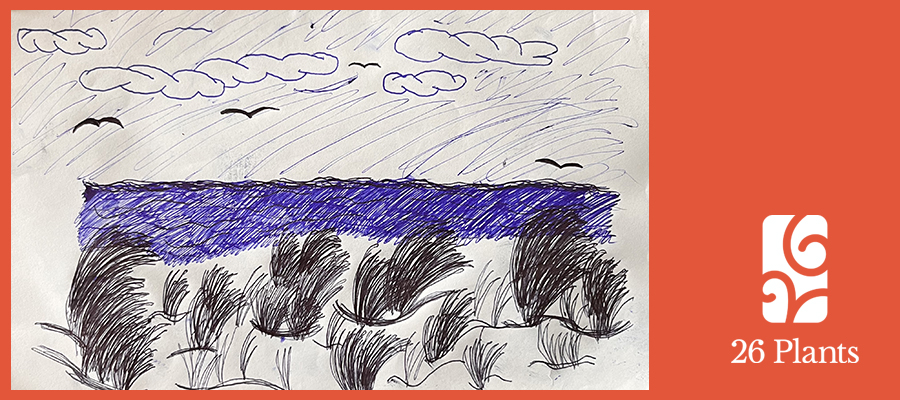Marram Grass
Ammophila arenaria
Margaret Kenna

Marram Grass Memories
It is wild
the place
where marram grass
lives with sea holly
the sounds of
stonechats calling
and surf
crashing to the shore
It kept a community in shoes
roofs and nets
for centuries
each family with their own dune
to farm
Now the same wild wind
means the habitats are shifting
even as you seek shelter
to eat sandwiches
with a side order of sand
and seashells
sharp grass blades
scratching your sea salt legs
We have been too free
to harvest it
and the dunes are
no longer tethered
by marram grass
we have forgotten
it is wild
Memories are made of Marram Grass…..
Marram grass is that grey, green prickly grass that scratches your legs when climbing up sand dunes. Perhaps not, at first glance, a “poetic” plant, but tough and resilient, it was always there, weathering the North East wind alongside us, while Dad tried to light the candles on a birthday cake, in the shelter of the dunes. We’d lugged the cake three miles along the dune path, jumping from tuft to tuft of marram grass and waging savage sword fights, with its long strands along the way. Perhaps we were an odd family, but those birthday celebrations have stayed with me, and there is poetry in those memories. Plus, as I have now discovered, marram grass is a very interesting plant.
Marram grass is a Xerophyte – thriving in arid conditions where most plants would curl up and die. Surviving happily on free-draining sand on windy coasts, it can retain water, due to its metres-long roots. These reach down in search of moisture, while creeping stems called rhizomes extend widthways below the surface, sending down even more ladder-like rooting structures along their length.
It is these underground networks that capture blown sand, and make marram grass perfect for stabilising shifting dunes. Healthy sand dunes act as a natural flood defence, they are also a sanctuary for endangered plants and animals, for example the natterjack toad, dune gentian and sand lizard. At the same time, the fibrous matted roots bind the sand down, encouraging the colonisation of other plants.
Native to the coasts of the North Atlantic Ocean, villages used marram grass for centuries for thatching, making shoes, fishing nets and feeding cattle. Each village would have its own dune to farm. In Inner Mongolia, it is now being used to try and stop the march of the Gobi desert across essential grassland.
Harvesting of marram grass was banned in the UK in the 17th Century when over enthusiastic cutting resulted in sand blowing inland, burying coastal villages and farms. Now sand dunes are now one of the most at risk habitats in Europe. Only 20,000 hectares remain across England and Wales – an area around half the size of the Isle of Wight.
Natural England are working in partnership with The Wildlife Trusts, Plantlife, and National Trust to explore how to re-establish the natural movement within dunes and create the conditions that some of our rarest wildlife relies upon.
Image by Sophie Cheng
